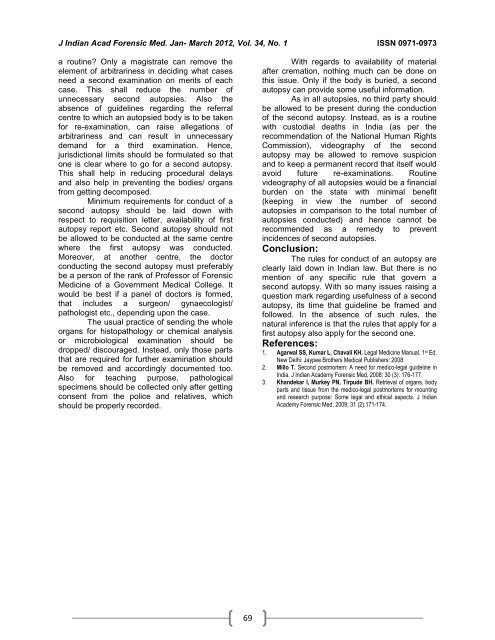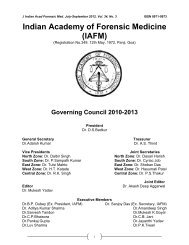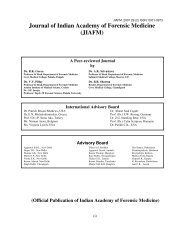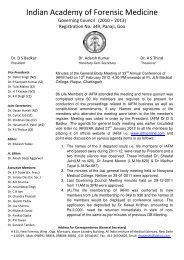Indian Academy of Forensic Medicine (IAFM) - Official website of IAFM
Indian Academy of Forensic Medicine (IAFM) - Official website of IAFM
Indian Academy of Forensic Medicine (IAFM) - Official website of IAFM
Create successful ePaper yourself
Turn your PDF publications into a flip-book with our unique Google optimized e-Paper software.
J <strong>Indian</strong> Acad <strong>Forensic</strong> Med. Jan- March 2012, Vol. 34, No. 1 ISSN 0971-0973<br />
a routine? Only a magistrate can remove the<br />
element <strong>of</strong> arbitrariness in deciding what cases<br />
need a second examination on merits <strong>of</strong> each<br />
case. This shall reduce the number <strong>of</strong><br />
unnecessary second autopsies. Also the<br />
absence <strong>of</strong> guidelines regarding the referral<br />
centre to which an autopsied body is to be taken<br />
for re-examination, can raise allegations <strong>of</strong><br />
arbitrariness and can result in unnecessary<br />
demand for a third examination. Hence,<br />
jurisdictional limits should be formulated so that<br />
one is clear where to go for a second autopsy.<br />
This shall help in reducing procedural delays<br />
and also help in preventing the bodies/ organs<br />
from getting decomposed.<br />
Minimum requirements for conduct <strong>of</strong> a<br />
second autopsy should be laid down with<br />
respect to requisition letter, availability <strong>of</strong> first<br />
autopsy report etc. Second autopsy should not<br />
be allowed to be conducted at the same centre<br />
where the first autopsy was conducted.<br />
Moreover, at another centre, the doctor<br />
conducting the second autopsy must preferably<br />
be a person <strong>of</strong> the rank <strong>of</strong> Pr<strong>of</strong>essor <strong>of</strong> <strong>Forensic</strong><br />
<strong>Medicine</strong> <strong>of</strong> a Government Medical College. It<br />
would be best if a panel <strong>of</strong> doctors is formed,<br />
that includes a surgeon/ gynaecologist/<br />
pathologist etc., depending upon the case.<br />
The usual practice <strong>of</strong> sending the whole<br />
organs for histopathology or chemical analysis<br />
or microbiological examination should be<br />
dropped/ discouraged. Instead, only those parts<br />
that are required for further examination should<br />
be removed and accordingly documented too.<br />
Also for teaching purpose, pathological<br />
specimens should be collected only after getting<br />
consent from the police and relatives, which<br />
should be properly recorded.<br />
69<br />
With regards to availability <strong>of</strong> material<br />
after cremation, nothing much can be done on<br />
this issue. Only if the body is buried, a second<br />
autopsy can provide some useful information.<br />
As in all autopsies, no third party should<br />
be allowed to be present during the conduction<br />
<strong>of</strong> the second autopsy. Instead, as is a routine<br />
with custodial deaths in India (as per the<br />
recommendation <strong>of</strong> the National Human Rights<br />
Commission), videography <strong>of</strong> the second<br />
autopsy may be allowed to remove suspicion<br />
and to keep a permanent record that itself would<br />
avoid future re-examinations. Routine<br />
videography <strong>of</strong> all autopsies would be a financial<br />
burden on the state with minimal benefit<br />
(keeping in view the number <strong>of</strong> second<br />
autopsies in comparison to the total number <strong>of</strong><br />
autopsies conducted) and hence cannot be<br />
recommended as a remedy to prevent<br />
incidences <strong>of</strong> second autopsies.<br />
Conclusion:<br />
The rules for conduct <strong>of</strong> an autopsy are<br />
clearly laid down in <strong>Indian</strong> law. But there is no<br />
mention <strong>of</strong> any specific rule that govern a<br />
second autopsy. With so many issues raising a<br />
question mark regarding usefulness <strong>of</strong> a second<br />
autopsy, its time that guideline be framed and<br />
followed. In the absence <strong>of</strong> such rules, the<br />
natural inference is that the rules that apply for a<br />
first autopsy also apply for the second one.<br />
References:<br />
1. Agarwal SS, Kumar L, Chavali KH. Legal <strong>Medicine</strong> Manual. 1 st Ed.<br />
New Delhi: Jaypee Brothers Medical Publishers: 2008.<br />
2. Millo T. Second postmortem: A need for medico-legal guideline in<br />
India. J <strong>Indian</strong> <strong>Academy</strong> <strong>Forensic</strong> Med, 2008; 30 (3): 176-177.<br />
3. Khandekar I, Murkey PN, Tirpude BH. Retrieval <strong>of</strong> organs, body<br />
parts and tissue from the medico-legal postmortems for mounting<br />
and research purpose: Some legal and ethical aspects. J <strong>Indian</strong><br />
<strong>Academy</strong> <strong>Forensic</strong> Med, 2009; 31 (2):171-174.









